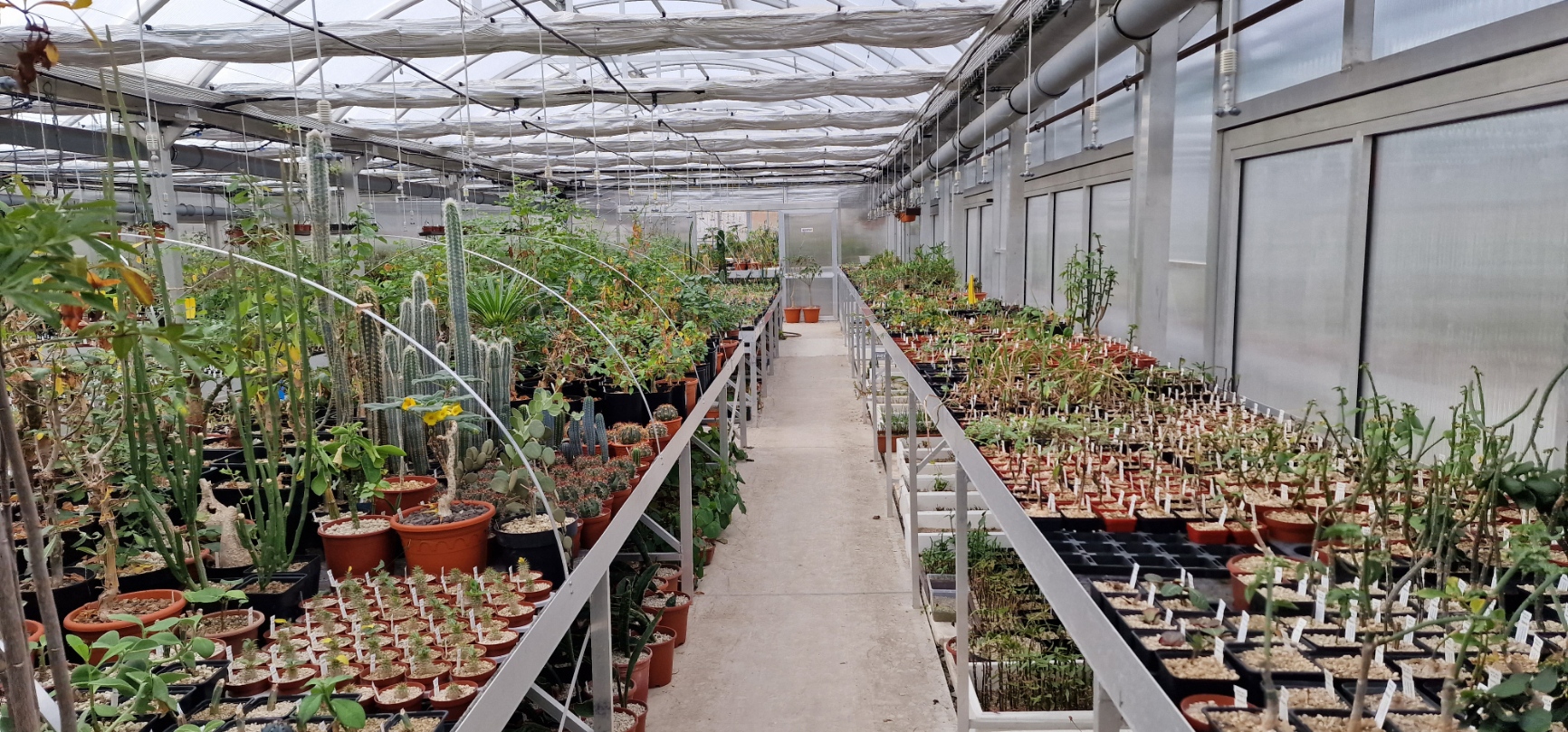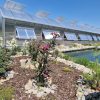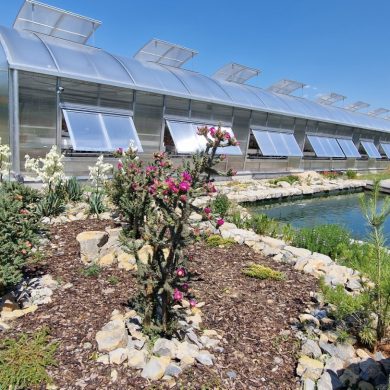Succulent plants of the family Aizoaceae, subfamily Mesembryanthemoideae, known as mesemb, are found mainly in South Africa and include 123 genera with about 2,500 species. The most famous group of mesembs consists of “flowering stones”, also “living stones”.
They include 17 genera with about 500 taxa (181 species without subspecies and varieties). Their characteristic feature, thanks to which they got their name, is the shape similarity with stones, so-called mimicry. Plants are therefore very difficult to find in nature. Their leaves are limited to only one or a few succulent pairs of leaves, usually from a few millimeters to a few centimeters in size. In the dry season, their size decreases even more and the bodies sink to the ground level or even below it. One pair of leaves is called a head, and a plant usually consists of several heads. The stem is not visible. The flowers in shades of white, yellow and purple (the red color of the flowers is absent) often reach a much larger size than the leaves.
Growing flowering stones requires more sensitivity than, for example, cacti or houseplants. However, if you follow a few basic rules, you will achieve good results and flowers even in residential conditions. These rules are: bright place, plenty of fresh air, permeable substrate and suitable watering. You can ensure a bright place by placing plants on the windowsill. Long-term direct sunlight has a negative effect, so it is necessary to provide shading and disperse the sun’s rays. The lack of light manifests itself in the stretching of the bodies and the loss of their natural shape. In this case, change the position of the plants immediately.
The plants come from windy areas with little air humidity. A wet environment leads to growth in unusual shapes, to the cracking of the bodies or in the worst case to the death of the plants. In apartments, the air humidity is at the desired value. When growing in a greenhouse or hothouse, it is necessary to ventilate regularly. Plants tolerate temperatures around 5-10°C without problems, even less in drought. The optimal temperature should be in the range of 15-25°C. At temperatures above 30°C, plants stop receiving water and can rot quickly after watering (especially in the sun). At that time, it is necessary to ventilate as much as possible, do not water and shade. In general, the more airflow you provide, the better the plants will tolerate higher temperatures and more sunlight. As a substrate, I recommend using a quick-drying mixture of river sand and horticultural substrate in a ratio of 50:50.
In one year, the plant produces only one pair of leaves. At the end of the growing season, the process of so-called “redressing” begins, when this pair of leaves (head) gradually dries up and a new pair is formed between or inside it, sometimes two or three. The plant goes from the vegetation period to the rest phase, so-called dormancy. At that time, it is necessary to limit watering or completely omit it. The regular supply of water will be resumed when the new pair (or pairs) of leaves are fully developed. Choosing the right watering method is the most difficult test of growing skills. Since the flowering stones come from very diverse areas, with a specific distribution of precipitation, the individual species have different periods of vegetation and rest during the year. In older literature, precise dates are often given for individual genera and species from when plants may and may not be watered. Such a dogmatic division does not apply and every year it is necessary to adapt watering to outdoor conditions. Even in nature, rain does not come on the same date every year, but always at a similar time. Certain principles apply in general to all mesemba, but each grower must find a way of watering according to his conditions, depending on temperature, humidity, light conditions and the substrate used. Therefore, consider the following division as a kind of private recommendation, which is based on fifteen years of experience growing mesemba in the greenhouse.
Mesemb representatives usually do not have strict requirements for watering and require water throughout the year. During the main growth period, as will be explained later, we water abundantly, but always after the flower dries up – intense growth takes place. Outside of the main growing season, we water less, minimally, but we rarely skip water completely, and we adjust the frequency of watering according to the appearance of the plants and the temperature. If a new, developing pair of leaves dries up, this is a sign of excessive water loss, so in such cases we water carefully even outside the growing season. Miniatures of the genera Conophytum, Oophytum, but also Gibbaeum, Faucaria, Cheiridopsis and small seedlings require water most often in this period. Lithops and Pleiospilos can survive without water at temperatures around 10-15°C all winter.
We can “artificially” divide Mesemb into 2 main groups:
Group 1
Long day or summer growing species with main growing season (April) May – October (November). These species go into a state of rest (dormancy) in autumn. Its beginning depends on when the “grandmother’s summer” ends, and the watering is adjusted accordingly. Likewise, in the spring, I recommend watering according to the weather. On sunny days, some plants may receive more water as early as February.List of genera: Bergeranthus, Carruanthus, Chasmatophyllum, Cylindrophyllum, Delosperma, Dinteranthus, Frithia, Hereroa, Lapidaria, Lithops, Malephora, Nananthus, Neohenricia, Pleiospilos, Rhombophyllum, Rhinephyllum, Schwantesia, Tanquana, Vanheerdea, Vlokia.
Group 2
Short-day growing, or genera with the main growth period in autumn and spring. These species wake up at the end of summer in August, grow intensively in autumn, when they require sufficient water and air. In winter, it usually goes through a kind of dormancy caused by low temperature and lack of light, then in spring they complete their growth.List of genera: Aloinopsis, Antimima, Argyroderma, Aridaria, Astridia, Bijlia, Cerochlamys, Cephalophyllum, Cheiridopsis, Conophytum, Didymaotus, Diplosoma, Drosanthemum, Faucaria, Fenestraria, Gibbaeum, Glottiphyllum, Ihlenfeldtia, Meyerphytum, Mitrophyllum, Monilaria, Muiria, Namibia, Odontophorus, Oophytum, Psammophora, Ruschia, Stomatium, Titanopsis, Trichodiadema.Some shrub genera can grow and flower all year round, especially Lampranthus, Drosanthemum.
Individual genera of flowering stones
Argyroderma
(11 species) The plants are characterized by a spherical to oval body 1-6 cm in size, with green to grey-green skin. It often produces clumps of heads. Flowers of various colors appear in autumn. Individual colonies are mostly inhabited by individuals with one flower color. However, neighboring populations of identical plants may bloom differently. A typical example is A. deleatii, where we distinguish three forms according to the color of the flower: the type form with a white flower, f. aureum with a yellow flower and f. roseum with a purple flower. I recommend skipping watering in full summer (July) and winter (December, January). It belongs to the transitional group between 1 and 2.
Conophytum
(91 species) This most diverse group of mesembs includes plants with typical winter growth (group 2). In nature, they are found along the coast of the Atlantic Ocean in the reach of winter fogs. Temperatures at that time range between 5-20°C, often with ground frosts in the mountains. Summers are dry and warm (30-35°C), but the plants almost exclusively inhabit shady rocky slopes and are not exposed to direct sunlight. Representatives of the genus Conophytum also include the smallest mesemb (one-headed C. acutum with a body size of 2-5 mm or C. achabense – 2 mm), but their flowers often exceed the size of the heads several times. Some species bloom at night, the flowers are much smaller than those of day-blooming species, but they are strongly scented. In the last 15 years, this genus has attracted much more attention among growers, and about 40 new taxa have been described.
Didymaotus
(1 species) This monotypic genus with one species D. lapidiformis belongs to the desired species. It requires dry and warm conditions with plenty of sun. That is why it is rarely represented in collections. One pair of wedge-shaped leaves (about 4cm) blooms with two pink flowers that appear on either side of the body. It belongs to the transitional group between 1 and 2 with summer dormancy.
Dinteranthus
(4 species) Typical flowering stones from central Bushmanland and southern Namibia are characterized by a short dormancy in midsummer and winter. Otherwise, they require irregular watering throughout the year, plenty of air and sun. The bodies reach 2-5 cm and the yellow flowers appear in late summer and autumn. A typical representative of group 1 with very small seeds.
Diplosoma
(2 species) These rarely grown miniatures with winter growth (group 2) are very short lived. Optionally, it can also be annuals. However, they mostly survive 2-5 years. In the summer, a small tuber (around 1 cm) remains underground, from which a few leaves (about 1-3 cm) with a typical crystalline skin and pink flowers grow.
Fenestraria
(1 species) There are two subspecies, F. rhopalophylla subsp. rhopalophylla with a white flower and subsp. aurantiaca with yellow flower. Both are found in sandy areas along the Atlantic coast from Port Nolloth (JAR) to Lüderitz in Namibia. Their bodies are mostly covered with sand, and only the upper surface of the leaf (5-10 mm) protrudes with a glassy window through which the sun’s rays are directed to the chloroplasts, where photosynthesis takes place. It forms bunches up to one meter in diameter. In culture, it requires dry air and summer dormancy. It belongs to group 2.
Frithia
(1 species) A single representative (F. pulchra) grows in the Dragon Mountains west and east of Johannesburg. The eastern form probably represents a second separate species. Its body shape is similar to fenestrariums, but it only reaches about 3-10cm in diameter and the purple or white flowers are wedged between the leaves. It belongs to Group 1, but at room temperature it can grow and flower all year round, so it can tolerate year-round watering.
Gibbaeum
(16 species) This morphologically very diverse genus with 18 taxa belongs to Group 2, but most species require sporadic watering throughout the year. They are characterized by different sizes of leaves in a pair, one is usually noticeably smaller. It originates from the Little Karoo region (about 200-300 km northeast of Cape Town), where most of the precipitation falls as fog in winter, but occasional thunderstorms can occur in the hot summer. White and pink flowering individuals often grow side by side in one population. The most beautiful species include G. album with silvery white skin or green G. petrense.
Ihlenfeldtia
(2 species) This genus was recently separated from the genus Cheiridopsis on the basis of the different structure of the fruit (capsule). Its two representatives (I. excavata, I. vanzylii) grow in the Bushmanland area. Especially small seedlings can resemble dinteranthus in body shape, but later they grow to a larger size and form bunches of 10-20 heads. The main growth period is in autumn, when they can bear a considerable amount of water. It belongs more to group 2.
Lapidaria
(1 species) The only representative of L. margarethae grows in southern Namibia and adjacent parts of Bushmanland (JAR). The development of seedlings in the first year coincides with lithops, with the next pair of leaves already forming a typical compact rosette 5-10 cm in diameter. In nature they are often colored pink or rust, in culture a whiter skin color prevails. Yellow flowers appear in autumn. It belongs to group 1.
Lithops
(37 species) The most famous group of living stones almost faithfully imitates the shape of stones, and plants that you have already discovered once in nature, you can very easily lose when you are looking for them again. So perfect are their camouflage skills, mimicry. It belongs to the summer-growing species (group 1) and tolerates complete omission of watering in winter. That is why they are among the most commonly cultivated flowering stones. Their bodies (heads) are covered on the surface by a drawing composed of colored lines, grooves and transparent areas. This upper surface of the leaf is called the face, and the appearance of the facial drawing serves as the main distinguishing feature of lithops. No two plants are exactly the same facially (just like humans), but the same species are characterized by a similar composition of characters. Therefore, each sowing can bring with it plants different from the parents. They bloom from June to November with yellow or white flowers. Recently, their popularity is increasing.
Muiria
(1 species) This species (Muiria hortenseae) is known from only one locality in the Little Karoo and is hardly found in collections due to the difficulty of cultivation. The leaf pair is almost perfectly fused into an egg shape (about 3-4cm) with a velvety felt skin. Plants require greenhouse conditions, with enough light and heat. It belongs to group 2, but I don’t recommend skipping watering for more than a few weeks. It grows together with Gibbaeum album, with which it crosses in nature (Muriogibbaeum album).
Namibia
(2 species) The plants come from the diamond regions of the Namib desert, around the town of Lüderitz. It produces tufts similar to Lapidaria margarethae with much softer skin. It belongs to group 2 and both known species (N. cinerea, N. ponderosa) appear very rarely in culture.
Oophytum
(3 species) These miniatures occur together with representatives of the genus Argyroderma. Nevertheless, their main growth period falls in the winter, and therefore belongs to group 2. Individual bunches form heads of 5-10 mm size, the size of the whole plant rarely exceeds 3-4 cm. Pink or white flowers appear in late winter and are very reluctant to bloom in culture. It does not belong to the commonly grown living stones.
Pleiospilos
(4 species) The genus Pleiospilos, popular especially for its large, fragrant, yellow flowers, is, like lithops, one of the most popular mesembs and is quite often represented in collections. These are easy-to-grow plants with summer growth (group 1), but it is much harder to tell the individual species apart. In addition, over time, numerous hybrids were created that “replaced” the true species. The most beautiful P. nelii produces an almost spherical body of 5-7 cm in size and can also bloom pink.
Tanquan
(3 species) This genus was originally part of the genus Pleiospilos, but is distinguished by a different structure of the capsule and skin. Apart from T. prismatica, the other two representatives (T. archeri, T. hilmari) reach much smaller dimensions (around 2-3 cm). They bloom in autumn with yellow flowers. It belongs to group 1 and during winter dormancy, adult plants can survive without water for several months.
Vlokia
(1 species) This new monotypic genus (V. ater) was described only recently and is hardly found in collections. Family relationships are not yet very clear. It occurs in the Little Karoo, near Montagu. Pink flowers appear in late winter or spring. It belongs to the transitional group between 1 and 2. Among the flowering stones we can also count some representatives of the genera Antimima, Bijlia, Cerochlamys, Cheiridopsis, Dracophilus, Vanheerdea.












Leave a reply